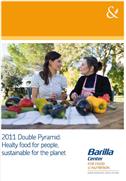BARILLA - Double pyramid - BCFN
2011 - The BARILLA double pyramid to understand food nutritional proporties and the environmental burden of food chains
Publication of the paper "Double Pyramid" of June 2010 gave the first strong signal on how important it was to pay attention to food choices, not only with regard to health of persons, but also, and this was the main innovation, on the importance of protecting the environment. The comparison between the traditional Food Pyramid for what concerns food nutritional properties and the “new” Food Pyramid, in which each type of food is positioned in regards to its impact on the planet, made it clear how the types of foods recommended by nutritionists for more frequent consumption are also those types that yield less impact on the environment.
A year has passed and many studies have been published regarding the environmental impacts of food, as many were the many comments we received (by experts and non-experts) on the occasion of various meetings and presentations.
In this new edition of 2011, the amount of data collected from both scientific literature and from the public environmental Databases has well tripled. The new data confirms the soundness of the work carried out and provides a more robust framework, from a scientific point of view, for the model at the base of the Double Pyramid of the Barilla Center for Food & Nutrition.
The Mediterranean diet, appointed in 2010 as Intangible Heritage of Humanity by UNESCO and recognized internationally as a complete and balanced eating pattern, gains greater confirmation as a more sustainable model for the environment.
Just as last year, the analysis of environmental impacts is not limited to the mere production stage, but follows the entire life cycle of food. This analysis takes into account three indicators: the Ecological Footprint, the indicator used to develop the Environmental Pyramid that measures the capability of our land to regenerate the resources used, the Carbon Footprint, which measures the emissions of greenhouse gases (GHG); the Water Footprint, representative of the consumption of water resources).
The document is available on http://www.barillacfn.com/en


All projects on LCA / FOOD
- BORD BIA (Irish food Board) - LCA Irish beef meat
- FEDERBIO - Organic farm
- COOP Italia & Fileni - LCA poultry meat production chain
- BARILLA - Analysis of durum wheat
- PFIZER - LCA/EPD IMPROVAC
- BARILLA - Double pyramid - BCFN
- BARILLA - Decalogue
- SKRETTING & COOP – Farmed fish LCA
- GSI - LCA of cold cuts
- VIP - LCA of Val Venosta Apples
- ORANFRIZER - LCA of oranges
- FILENI - LCA of poultry meat
- BRIMI - LCA of dairy products
- BONDUELLE - LCA of fresh cut salad production
- EUROVO - LCA of eggs production
- LIEKEN - LCA of wheat cultivation
- EKRO - LCA of meat production
- QUINTO VALORE - LCA of meat production
- INALCA - LCA of meat production
- VERGNANO - LCA of coffee capsules for Espresso
- GRANAROLO LCA for dairy and milk products
- COOP Italia - LCA of food products